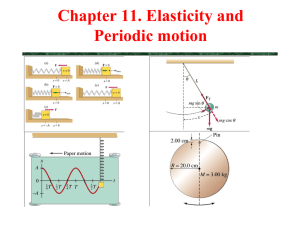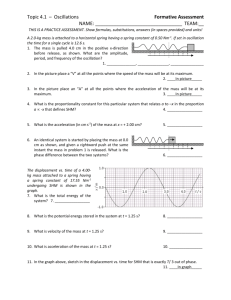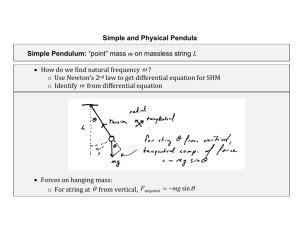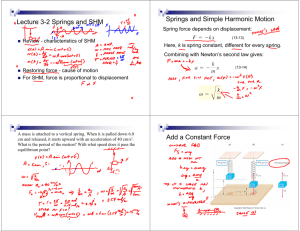(Periodic). The converse is not true. Every periodic
advertisement
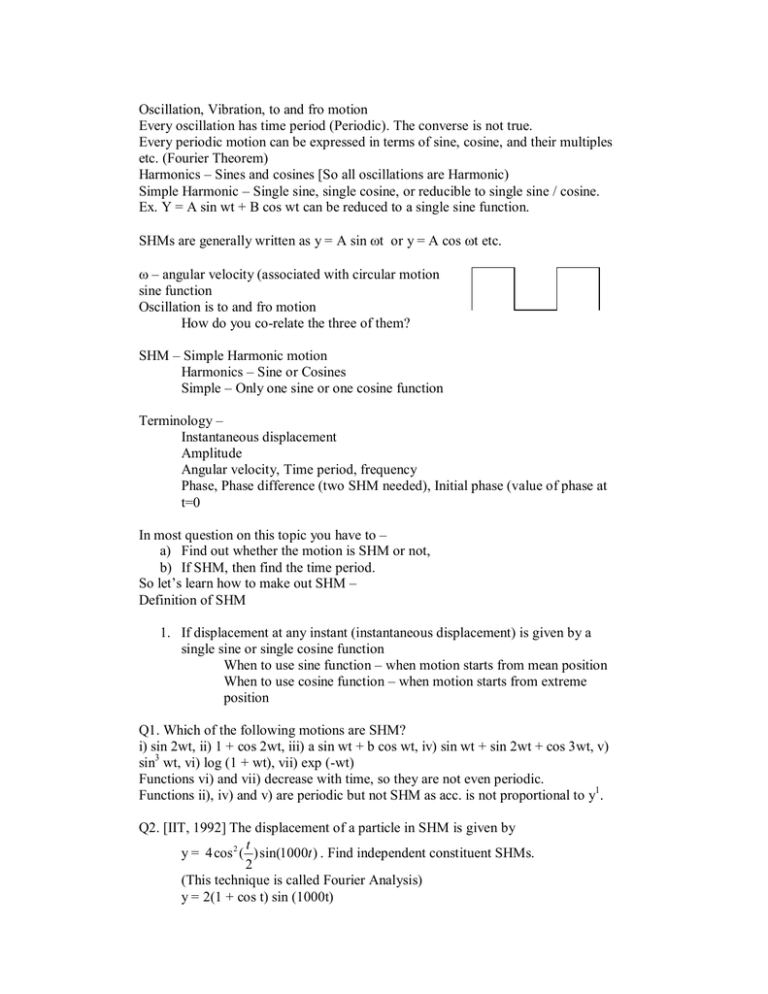
Oscillation, Vibration, to and fro motion Every oscillation has time period (Periodic). The converse is not true. Every periodic motion can be expressed in terms of sine, cosine, and their multiples etc. (Fourier Theorem) Harmonics – Sines and cosines [So all oscillations are Harmonic) Simple Harmonic – Single sine, single cosine, or reducible to single sine / cosine. Ex. Y = A sin wt + B cos wt can be reduced to a single sine function. SHMs are generally written as y = A sin t or y = A cos t etc. – angular velocity (associated with circular motion sine function Oscillation is to and fro motion How do you co-relate the three of them? SHM – Simple Harmonic motion Harmonics – Sine or Cosines Simple – Only one sine or one cosine function Terminology – Instantaneous displacement Amplitude Angular velocity, Time period, frequency Phase, Phase difference (two SHM needed), Initial phase (value of phase at t=0 In most question on this topic you have to – a) Find out whether the motion is SHM or not, b) If SHM, then find the time period. So let’s learn how to make out SHM – Definition of SHM 1. If displacement at any instant (instantaneous displacement) is given by a single sine or single cosine function When to use sine function – when motion starts from mean position When to use cosine function – when motion starts from extreme position Q1. Which of the following motions are SHM? i) sin 2wt, ii) 1 + cos 2wt, iii) a sin wt + b cos wt, iv) sin wt + sin 2wt + cos 3wt, v) sin3 wt, vi) log (1 + wt), vii) exp (-wt) Functions vi) and vii) decrease with time, so they are not even periodic. Functions ii), iv) and v) are periodic but not SHM as acc. is not proportional to y1. Q2. [IIT, 1992] The displacement of a particle in SHM is given by t y = 4 cos 2 ( )sin(1000t ) . Find independent constituent SHMs. 2 (This technique is called Fourier Analysis) y = 2(1 + cos t) sin (1000t) = 2 sin (1000t) + 2 sin (1000t) cos t = 2 sin (1000t) + sin (1001t) + sin (999t) So, the given expression is the result of 3 independent harmonics. 2. Starting from above definition y = A sin wt v(t) = Aw cos wt v(y) = w A2 y 2 a(t) = -w2Asin wt a(y) = -w2 y A motion is SHM if velocity is given as above OR acceleration is given as above. Q1. Plot all the functions given above. Q2. A particle is executing SHM with amplitude A and has a maximum velocity V0. a) At what displacement will its velocity be V0/2? b) What is its velocity at displacement A/2? 3. From a = -w2y, F = -mw2 y. If F is of the form F = (disp)1 , then it is SHM. Y is displacement. (-y) is opposite to displacement. So this force is opposite to displacement. Its called Restoring Force. 4. If in an oscillatory motion the amplitude is very small, then motion is SHM. Examples – an electron kept between two protons. In questions we follow the following steps – a) See if there is a position of equilibrium (net force is zero. For rotational SHM see if net T = 0), b) See if the equilibrium is stable, + + + Stable equilibrium + + Unstable equilibrium c) Calculate the restoring force, d) If it is of the form F = (disp)1 , then it is SHM. e) To find time period, compare it with F = -mw2 y (put the contents in the box equal to “mw2”) Questions on Translational SHM – 1. Cylinder in water, 2. Spring – horizontal, (for questions on springs see below) If spring has a mass Ms, then effective mass = M + (Ms /3) If two masses are connected by a spring, reduced mass M = 3. 4. 5. 6. 7. M 1M 2 M1 M 2 Spring – vertical (T is same, only mean position changes) Block kept between two springs, Block attached to two springs kept parallel to each other, Block attached to two springs in series, Oscillation of water column in U-tube, mass kept between two masses or on the axis of a ring condition for SHM amplitude to be small, electron kept between two positive charges or on the axis of positive ring condition for SHM - amplitude to be small, Questions on springs (Translational SHM) – 1. Figure below shows a system of massless Pulley, a spring (K = 4000), and a block (M = 1 kg). Find frequency in each case. A B C The dark boxes represent springs. A) Expansion of y in spring causes the block to move down by ‘y’. F = - k y B) In balance position – force in spring = ky0. Force in string = ky0/2. So ky0/2 = mg If block moves down by ‘y’, spring stretches by ‘y/2’ (understand it the other way out – an expansion of y/2 in spring cause the block to move down by ‘y’) New force due to spring = k(y0 + y/2) 1 Upward force on mass M is = k(y0 + y/2) 2 As ky0/2 = mg, so restoring force is ‘ky/4’. = (k/4)y C) k = 4k 2. Find time period in the following two cases. Ans. – a) 2 5m k b) 2 5m 4k 3. Two masses M1 and M2 are suspended together by a massless spring (k). In equilibrium, M1 is gently removed. Find frequency and amplitude. m2 As only M2 is there, so T = 2 . Stretch produced by M1 will k mg determine the amplitude = 1 k 4. A body of mass 1 kg is suspended by a spring (k = 600). Another mass (m = 0.5 kg) moving vertically up hits the suspended body with a velocity of 3 m/s and gets embedded in it. Find frequency and amplitude. 1 k f= 2 ( M m) cons. p – find v. Total KE after collision will change to PE at highest point. 1 1 A = 5 cm. ( M m)v 2 kA2 2 2 5. A horizontal spring-block system (k, M) executes SHM with amplitude A. When passing through equilibrium position, another mass ‘m’ is placed on it 6. and they move together. Find new amplitude and frequency. 1 k 1 k f= , f’ = 2 M 2 ( M m) v = A (2f) , Conserve p –> Mv = (M + M) V’ => M A (2f) = (M + M) A’(2f’) 7. Two light springs (k1 and k2) and a block of mass ‘m’ are placed as shown. The distance CD between the springs is 60 cm. The block moves in between the springs with v = 120 m/s. Calculate the period of oscillation. (k1 = 1.8, k2 = 3.2, m = 200 g). Is the motion SHM? [Ans. 2.82 s, Oscillatory but not SHM] K2 K1 A C D B 8. [Scan and insert pic] A particle of mass ‘m’ is attached to three identical springs A, B and C each of force constant ‘k’ as shown. If the mass ‘m’ is pushed slightly against the spring A and released, find time period of oscillations. B 900 450 A C 9. The springs are joined as shown. A constant force F is applied. Find amplitude and frequency. 10. Two masses of ‘m’ each are joined to the two ends of a spring. Find T. 11. A simple pendulum with L = 40cm is taken into a mine (1600 km deep). Find T. 12. A body of mass M falls from height H on to a spring of spring constant K and sticks to it. Find the amplitude and frequency of vibration. 13. Q. 16, pg. 253 (HCV1) based on above question (but in horizontal direction) a) Find amplitude, frequency of Oscillation, b) PE of spring when block is at left extreme, c) PE of spring when spring is at right extreme. Questions on Rotational SHM – 1. Simple Pendulum, If bob has radius ‘r’ – replace l with l + r (Also MI of sphere has to be taken now). Replace solid bob with hollow. What if the hollow bob is filled with water which is leaking? Girl on a swing stands up? Graph T-L, T-L, Effect of temperature, if bob is suspended by wire - T 1 T 2 Effect of elasticity (wire stretches by L) Mg L L L L L T = 2 = 2 [1 ] = 2 [1 2 ]1/ 2 g g L g r Y Mg L [1 ] see question at the end. 2 r 2Y g If a simple pendulum of density ρ is made to oscillate inside a liquid of density , g will be replaced by g’, where mg’ = mg - Vg If pendulum oscillates in a lift Acc up – g g + a Acc down – g g - a freely falling lift, g’ = g – a = 0, T is infinite. If the pendulum is in an accelerated carriage, replace g with effective g. Also carriage moving on circular track. If a charged bob is doing SHM in E-field, g’ is resultant of g and qE/m. Maximum time period of an oscillating bob is 83.8 minutes (L>>RE) If T = 2 s, it is called seconds pendulum. = 2 2. Compound Pendulum / Physical Pendulum a) Any general body b) Ring about one end. 3. A light rod of total length L2 is as shown Find its frequency and equivalent length. L1 L2 M1 M2 (m1L1 m2 L2 ) g m1 L12 m2 L22 What is the effect if the rod has mass M and M1 and M2 are spheres of radii R1 and R2 respectively? Take one rod and one bob for simplicity. Ans. 2 4. A simple pendulum of length L and mass m has a spring (K) connected ‘h’ below the point of suspension. Find frequency. [mg ( L sin ) k (h tan )h] for small , (mgL kh2 ) f 1 2 ky mgL kh 2 mL2 5. Two identical pendulums (L) connected by springs (K). Find T when they move in opposite direction. On any pendulum, (I = mL2) [mgL sin k (2 y) L] [mgL sin k (2 L sin ) L] [ mgL 2kL2 ] y 1 g 2k [ ] 2 L m 6. [Scan and insert pic] A Rod (M, L) is connected to spring (k) and wall as shown. In equilibrium, the rod is parallel. a) Find period of oscillation. b) What will be the maximum speed of the displaced end of the rod if the amplitude of motion is 0. m Restoring T = -(ky)L = -k(L)L = -kL2 T = 2 3k f 7. Rod (Mass – M, length – L) connected to two springs of ‘k’ each. Find T. 8. Determine the time period in the following case. 9. Rod (M, L) hinged at top oscillates in the plane of the paper. Combined k is ‘k’. Find T. 10. Find T for vertical oscillation of C.M. (Ex. 7, pg 244, HCV1). The pulley has moment of Inertia I about its axis and mass M. The spring has spring constant K, and the string does not slips over the pulley. Kinetic Energy Potential Energy Graphs - Also the cases when PE is not zero at mean position. Conservation of Energy approach – 1. A cylinder attached to a spring rolls without sliding. Find its frequency. Questions on reduced mass – 1. Two identical balls A and B each of mass 0.1 kg are attached to two identical springs (L = 0.06 m, k = 0.1 N/m) and is constrained to move as shown. R = 0.06 m. Initially, both the balls are displaced by an angle /6 rad w.r.t. diameter PQ and released. a) Calculate frequency of ball B. b) What is the total energy of the ball B. c) Find the speed of the ball A when A and B are at the two ends of the diameter PQ. Sol. This is a question of reduced mass, m = m1m2 . Also Keff = k1 + k2 m1 m2 f = 1/ 1 1 b) E = k1 y 2 k2 y 2 = ky2. y = y1 + y2 = 2y = 2(R x ) 2 2 6 E = 42 x 10-5 J 1 1 c) m1v12 m2 v22 = E = 42 x 10 -5 v = 2 x 10 -2 m/s 2 2 2. A diatomic molecule has atoms of masses m1 and m2. The PE of the molecule is given by U(r) = -A + B(r – r0)2, where r0 is the equilibrium separation and A and B are positive constants. The atoms are compressed towards each other from equilibrium position and released. What is the vibrational frequency? dU Sol. F = = -2B(r – r0) = -2Bx, where x is the displacement of the reduced mass. dr 2B d 2x 2 2 2 Bx dt 3. General Questions – 1. Two SHMs are represented by y1 = 10 sin [ 3t + (/4)] and y2 = 5 [sin(3t) + 3 cos (3t)] Find the ratio of their amplitudes. nd 2 SHM can be written as 10 sin [3t + (/3)]. So the ratio is 1:1. 2. Two linear SHMs of equal amplitudes and frequencies w and 2w are impressed on a particle along x- and y-axes respectively. If the initial phase difference between them is /2, find the resultant path followed by the particle. x = a sin wt y = a sin [2wt + /2] = a cos 2wt 1 By substitution etc. x2 = a ( y a ) Parabola. 2 The path thus traced is called Lissajous figure. 3. A block is resting on a piston which is moving vertically with a SHM of period 1 s. At what amplitude of motion will the block and piston separate? What is the maximum velocity of the piston at this amplitude? Block will not separate if N > 0 => M(g – a) > 0 => g>amax => g > w2A. So ‘A’ can be calculated. From this Vmax = Aw 4. A block is kept on a horizontal slab which is moving horizontally with a SHM of frequency two oscillations per sec. ‘µ’ between block and slab is 0.5. What can be maximum amplitude so that the block does not slips? Block will not separate if ma < µmg w2A < µmg 5. In SHM, a) What fraction of energy is kinetic when displacement is half the amplitude, b) At what displacement is the KE and PE equal? Ans. a) fK = ¾, fp = ¼, b) at y = A/2 6. A simple pendulum is made by attaching a bob of 1 kg to a 5m long copper wire of diameter 0.08 cm and it has a certain period of oscillation. Next a 10 kg bob is substituted for the 1 kg bob. Calculate the change in T (Y for Cu = 12.4 x 1010 N/m2) g L [1 ]( M 2 M 1 ) = 0.0031 s 2 2 r 2Y g 8. [Q. 50, pg. 255, HCV1] A uniform disc of radius R is to be suspended through a small hole made in the disc. Find the minimum possible time period of the disc for small oscillations. What should be the distance of the hole from the centre for it to have minimum time period? [ 2 9. r 2 , at a distance of r√2] g from Narayana (2007-08) material – 1. Two rods (L1, L2) having masses M1, M2 joined to their ends are joined from the other ends. Hinged at the joint. Find T. 2. Bullet of mass M2 strikes a block of M1 with Vo and gets embedded in it. Find T and amplitude of oscillation.

